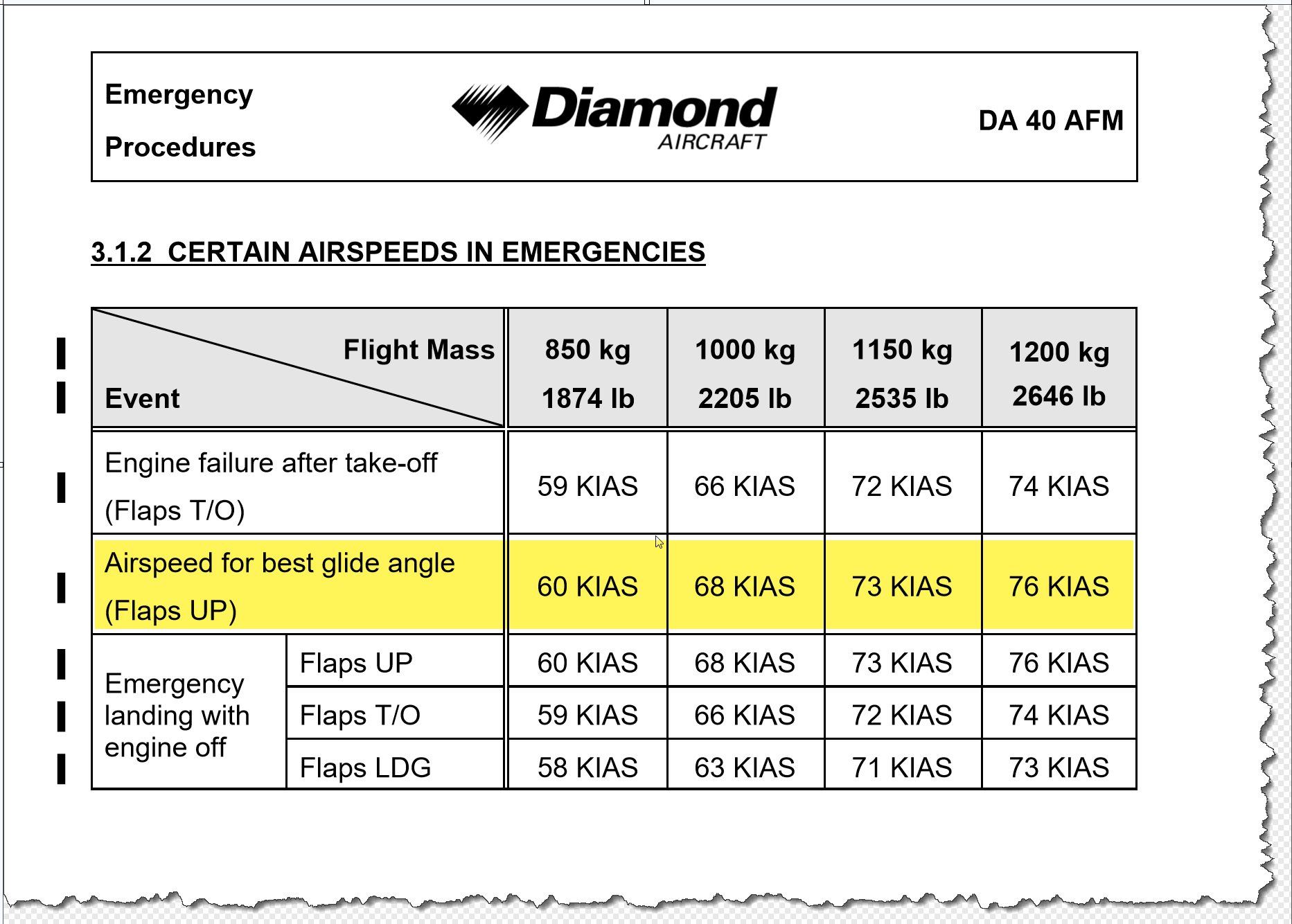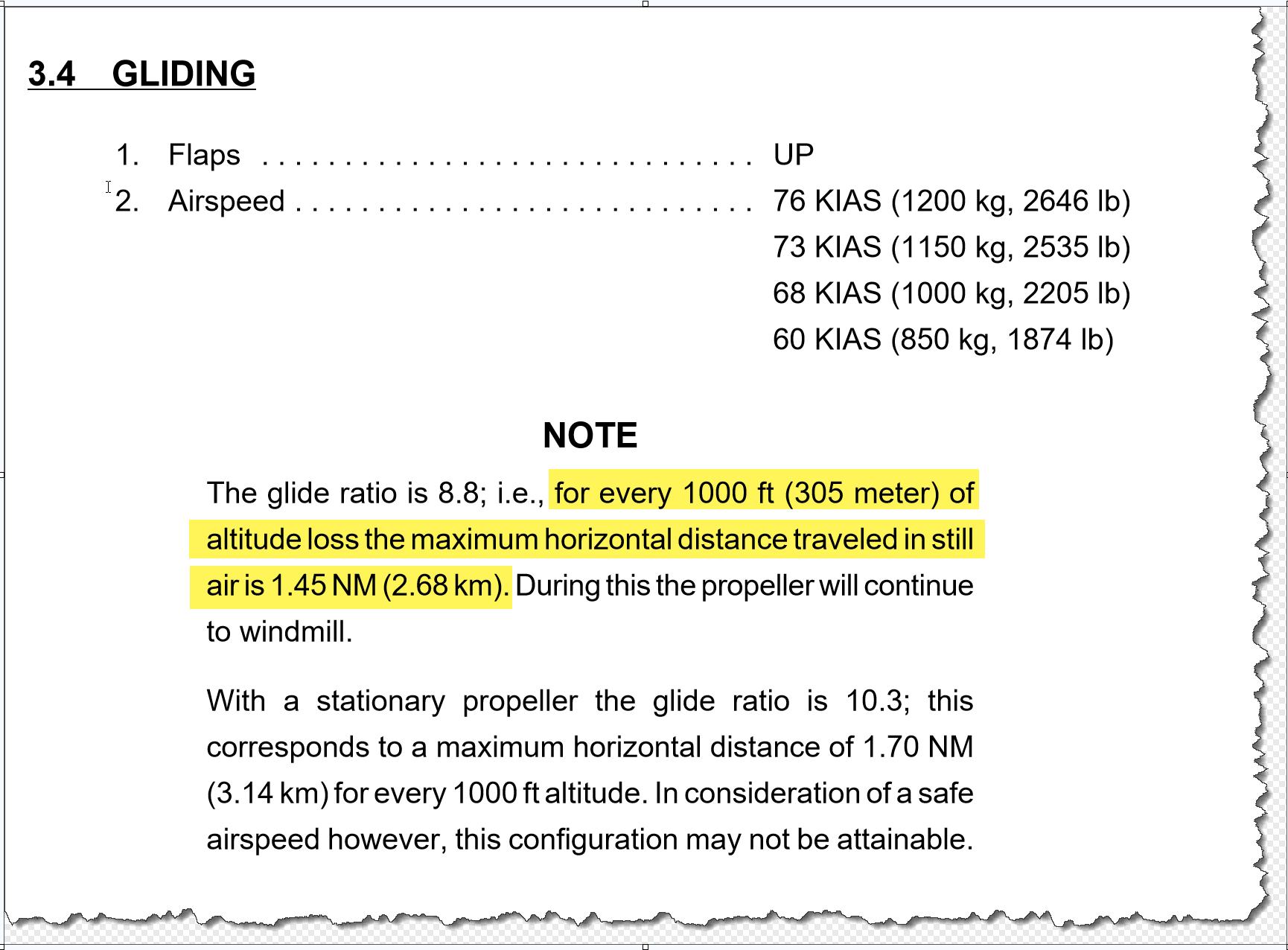Page 1 of 4
Engine failure best glide speed descent rate
Posted: Tue Jul 23, 2019 2:07 am
by 40flyer
Has anyone determined the descent rate in fpm when descending engine out (let’s say idle throttle) at best glide speed (e.g. 73 kts)?
Re: Engine failure best glide speed descent rate
Posted: Tue Jul 23, 2019 12:46 pm
by gordsh
Having recently completed my PPL I had to get intimate with these numbers. Below are the numbers from the POH that I use:


Re: Engine failure best glide speed descent rate
Posted: Tue Jul 23, 2019 2:39 pm
by Rich
Converting to VS in the simplified case from the table is a fairly straightforward formula:
VS = AS*(6076/60)/GR
Simplifies to: AS*101/GR
e.g. 73 KIAS at 8.8 ratio yields: 838 f/m, at 10.3 GR = 716 f/m
Where AS is airspeed in knots, VS is vertical speed in f/m and GR is Glide ratio*.
Additional info: 1 nm = 6076 ft. Therefore 1 kn = 6076 ft/hr = 6076/60 ft/min
*Using glide ratio directly introduces an inaccuracy in the third decimal place for these relatively shallow angles.
Notes:
1. This is, of course the simple, no wind case and ignores density altitude effects. "AS" should more accurately be TAS in no-wind case.
2. With the engine at idle, glide ratio is better than the dead-engine case. So practicing engine-out with the engine still running gives flatter glide and lower descent speeds.
Re: Engine failure best glide speed descent rate
Posted: Tue Jul 23, 2019 3:49 pm
by Boatguy
Great subject!
For the DA40NG that would be 88 * 101 / 9.7 = 916fpm. The AFM also computes a glide radius of 1.59nm (2.94km) per 1,000' AGL.
The AFM goes on to say:
The propeller will keep windmilling under all expected conditions. Do not attempt to stop the propeller intentionally. In case of stationary propeller the given numbers are conservative.
Re: Engine failure best glide speed descent rate
Posted: Tue Jul 23, 2019 4:26 pm
by Steve
I have found during engine-out practice, that pulling the prop RPM back does extend the glide significantly. I haven't done any quantitative experiments, but the effect seems to be at least 10%.
Re: Engine failure best glide speed descent rate
Posted: Tue Jul 23, 2019 5:58 pm
by astaib
And remember that a 180 turn will make a loss of 500ft
Re: Engine failure best glide speed descent rate
Posted: Wed Jul 24, 2019 9:28 pm
by 40flyer
Thanks all for the input. I did a similar calculation but was wondering if anyone had the actual performance. My reason for asking was my planned flight across Lake Michigan enroute Oshkosh. At the narrow point it’s 46 nmi so at 14k ft and a 68kt glide speed that means 18-19 min descent time. So a 10 min exposure time mid-lake at the extreme. With a headwind the numbers of course change. I’ll wear a life jacket just in case and be watching the engine-out glide ring on Foreflight like a hawk.
Re: Engine failure best glide speed descent rate
Posted: Wed Jul 24, 2019 9:42 pm
by astaib
I’ll have in 2 weeks as well 2 flights away from the coast between Italy and Corsica. And then between Corsica to France.
49 nm from coasts in the middle of the flight.
4 of us (2 kids) will wear life jackets and I will look at the vm1000 a lot.
Arnaud.
Re: Engine failure best glide speed descent rate
Posted: Wed Jul 24, 2019 9:59 pm
by Colin
Don,
I did exactly that calculation in my DA40 and my younger son and I crossed at 14.5 (I think). But I remember the same answer: for 12 minutes we would be out of gliding distance of either shore.
Since then I have remembered: the engine failure is VERY rarely catastrophic to 0% thrust. So know the midpoint (with wind) and know whether you are turning back or pressing on. And getting near to a boat if you are coming down is a really good idea. The plane isn't yours at that point, it's just a ride to the water. Even with OSH happening I insisted on flight following. I think I said I had a child on board and non-swimmer.
Re: Engine failure best glide speed descent rate
Posted: Wed Jul 24, 2019 11:39 pm
by RMarkSampson
If you fly over Lake Michigan at 100 ft, it won't help the glide distance, but it does make the math easier...


